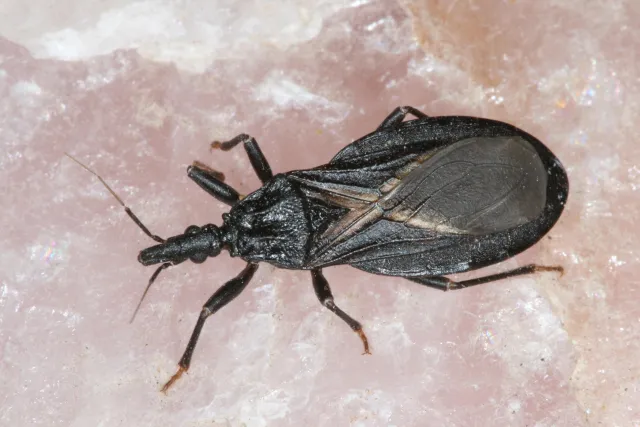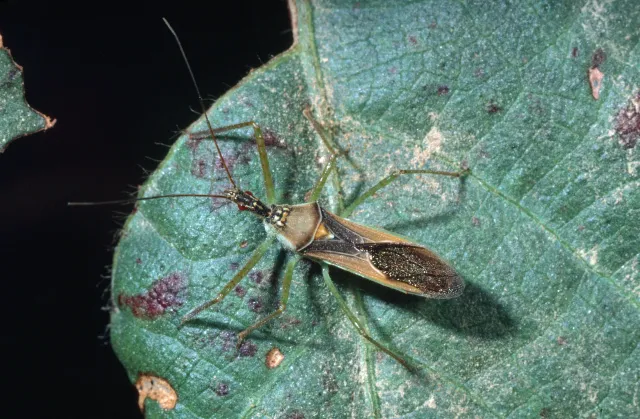
As the weather heats up, insects become more active and abundant. People will encounter different species of insects depending on where they live. For example, individuals living in urban centers may only routinely see insects that thrive around humans, such as ants, roaches, and flies, while those that live in suburban and rural areas with more open space will cross paths with a much broader variety of species. One summertime insect that occasionally enters rural homes or those built near undeveloped wildlands is called the kissing bug. Never heard of kissing bugs? Well, they aren’t insects you really want to kiss!
About kissing bugs
Kissing bugs (also called “conenose bugs”) are blood-sucking insects found throughout the Americas, including most states in the southern half of the U.S. In California, three species of kissing bugs occupy a variety of natural habitats from the coast to foothill and mountain areas, as well as deserts. The “western conenose,” Triatoma protracta, is the most common and widespread of the three. These insects live in close association with vertebrate animals, especially rodents, where they feed exclusively on their host’s blood.
On warm summer and fall evenings, adult kissing bugs may take flight in search of new hosts. Like many nocturnal insects, they are attracted to artificial lights and may then enter homes through open windows or gaps under doors. Once inside, kissing bugs search for a host and often find their way to couches and beds where they feed on people and pets while they rest or sleep.

What to look for
Kissing bugs have a flattened, dark brown or black body, a long, cone-shaped head, and short, thin legs. Adult kissing bugs are about ½ inch long and have wings folded on their backs, while juvenile life stages are wingless. There are other insects in North America that, at first glance, resemble kissing bugs. These are mainly harmless plant-feeding species, but the so-called assassin bugs can deliver a painful bite. Closer inspection of these imposters usually reveals features that kissing bugs do not have such as bright coloration, thick hind legs, rounded head, or antennae with thick or clubbed ends. However, there are some harmless species that are much more difficult to tell apart without experience.
Just a kiss?
Kissing bugs feed only on the blood of vertebrates, with a preference for rodents, but will feed on many species including humans. They inject anesthetic saliva with their needlelike mouthparts through the skin to suck up blood without disturbing the host. Their bites are usually painless, and many people may never know they were bitten. However, some people experience allergies to the bug’s saliva with a range of reactions. Mild reactions are most common and may include redness and irritation of the skin, itching, and swelling around the bite area within 24 to 48 hours. A much smaller percentage of people may experience more severe reactions after a bite, including anaphylaxis, which can be very serious and cause difficulty breathing. People who have severe allergies and live in areas where kissing bugs are common, or who have experienced severe reactions to kissing bug bites in the past, should talk to a healthcare provider about the need to carry or use an injectable epinephrine device (like an “EpiPen”) for use in emergencies.
Kissing bugs are also infamous for transmitting the parasite that causes Chagas disease. Chagas disease transmission is very rare in the United States, but it is a concern in rural areas of Latin America including in Mexico, Central America, and South America. The blood parasite that causes Chagas disease only comes from the feces of an infected kissing bug. A person must scratch or rub fresh kissing bug feces into their eyes, nose, mouth, or a break in the skin to become infected with the parasite. A person cannot get Chagas disease directly from the bite of a kissing bug.
Learn more about Chagas disease at About Chagas Disease.

Keeping bugs where they belong – outside
Kissing bugs in California usually only encounter people who live outside of city centers, such as along the edges of suburban developments, or in more sparsely populated areas. Homes near or surrounded by natural habitats are likely to attract these insects on warm evenings. Fortunately, kissing bugs in California are not known to infest homes, and thus are usually limited to the status of an unwelcome seasonal visitor. In rare cases, a female kissing bug may enter a home and lay a few eggs that result in offspring that will survive with regular blood meals.
Nobody wants blood-sucking insects in their homes or wants to risk a severe allergic reaction from bites. If you live in an area with kissing bugs, or think they could be in the environment around your home, follow these steps to minimize attracting bugs to your home, prevent bugs from entering, and protect yourself from bites:
- Seal windows and doors with weather stripping, sealant, and caulk to close all cracks.
- Install tight-fitting door sweeps or brushes underneath exterior doors.
- Make sure window screens, door screens, and pet doors fit tightly. Seal any gaps where bugs might be able to crawl through.
- Add screens to chimneys, attic and crawl space vents, and other potential entry points to prevent rodents and other small animals from living inside your home. Kissing bugs can be attracted to and breed in rodent nests.
- Reduce the brightness of outdoor lighting and consider replacing outdoor lights with yellow, warm-tone, or low-UV light bulbs that are less attractive to night-flying insects.
- Clean up clutter around and from under your home that could attract and harbor rodents and kissing bugs. Store piles of firewood away from the house.
- Avoid hitchhiking kissing bugs: check firewood and other outdoor items before carrying them into the house.
- Use light-colored bedsheets and check bedding before going to sleep.
If you follow these suggestions but still have a problem with kissing bugs inside of your home, you may need to call a licensed pest control company to inspect and treat your home for pests.
For more information about kissing bugs, visit:
- California Department of Public Health Conenose (Kissing) Bugs and Chagas Disease webpage: https://www.cdph.ca.gov/Programs/CID/DCDC/Pages/Conenose-Kissing-Bugs.aspx#
- CDC Information on Species of Triatomine Bugs in the United States: https://www.cdc.gov/chagas/hcp/species/
- Texas A&M University – Kissing Bugs & Chagas Disease in the United States FAQ: https://kissingbug.tamu.edu/FAQ/
- UC IPM Pest Notes: Conenose Bugs: https://ipm.ucanr.edu/PMG/PESTNOTES/pn7455.html
[Originally featured in the Summer 2025 edition of the Home and Garden Pest Newsletter.]

